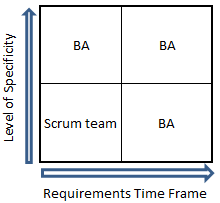
The Active BA
The purpose of this article is to encourage Business Analysts to be active in your role.
On some teams the BA is a project management support role rather than a leader. While PMs always need our assistance, all projects benefit from having a strong BA with a focus on delivering the business needs. I extend the concept to include proactive and reactive
- Be Active. Don’t be a passive member of the project team. Be active in meetings, in proposing ideas, and contributing to the discussions
- Be ProActive. Create and present a business analysis plan and BA methodologies to the project team
- Be ReActive. Be ready to react quickly when new information, technology or needs are introduced
Be Active
Be active in meetings, in proposing ideas, and contributing to the discussions.
Project meetings can be a lot of fun. The exchange of ideas among technology experts can be uplifting and inspirational. Requirements gathering meetings can also be lively and productive as stakeholders share their knowledge and ideas. But sometimes meeting can be dull and they can be frustrating, especially when participants go off track or monopolize the discussion. Whatever the situation, the active BA is leading or contributing to the discussion. There are two techniques that can help – Preparation and Presence.
Preparation means know your subject.
Within the project team we are the conduit between the technology teams and the business they are supporting. We can bring to the project team an understanding of the user needs and of management’s expectations of how the technology product / output will benefit their organization. It is not necessary to be a Subject Matter Expert in the technology or in the user’s business domain, but you should have sufficient knowledge of both to be an effective liaison between the customer and the development team. Stay current with the technologies of your architecture and your business. Be active in offering your ideas. It is especially important to offer your thoughts in project meetings on requirements that are implied in discussions. Clarify early and often.
The BA Times article Mind Maps for Business Analysis shows how to use the 5W Mind Map to present requirements and anchor team members during project meetings.
Before the first requirements gathering session make sure that you have some understanding of the organization and business of your stakeholders. In large organizations it may be necessary to create your own org chart to place the stakeholders and at least recognize where there may be differing expectations. Talk to a few individuals to get a sense of direction. Think of this as you would a vacation trip to a new country, where research and talking to others who have been there helps get the best out of your days once there.
For all requirements meetings ensure that you have a powerpoint or other visual display to keep focus on today’s agenda and current topic, with an appendix readily at hand of all requirements and decisions previously confirmed. To run a good meeting, be prepared with 1) visual clues and 2) the ability to steer discussion back to the subject of your choice. The latter requires presence.
Presence means having the ability to focus the audience on you and your line of discussion.
There are many tricks and tips for controlling meetings. Agendas, time boxed discussions and parking lots all help, but even with these a facilitator with no Presence can lose an audience.
Entertainers have presence. They move around the stage and engage their audience. Elton John played a piano, but he jumped around that piano to keep the audience eyes on him. When it’s time to focus the audience, stand up and move around as you speak. Use hand movements and point to the presentation as needed. Write comments on the wall boards while you continue the dialog. When you have made your point and want member discussion, sit down and allow the focus to move back to them.
Speak with strength when talking to your audience. I have an accent which goes down well with my local audience, but that alone would not keep their attention if I mumbled. The meeting room is your stage and your role is “Powerful BA”.
Another lesson from the entertainment business is practice. Strong speaking skills can be developed with practice. If your organization has a BA work group, then use this to present a topic to your peers. If you are part of a local IIBA Chapter then volunteer to make a presentation.
Be ProActive
Create and present a business analysis plan and BA methodologies to the project team.
The proactive BA starts with a business analysis plan and BA methodologies, then presents the plan to the project team during a kick off meeting so that they understand and support it. The plan should include roles and responsibilities with regard to requirements analysis, In a great project team, and especially in scrum teams, there is a degree of this analysis conducted by technical members. The business analysis plan will set boundaries for the team to understand who is responsible for getting requirements to a level of specificity so that can be ingested by the developers.

The BA operates in a continuous change environment, so continuous learning is an essential part of the Active BA career. Learning should include development of BA skills as well as staying current with technology. One of my recent projects was migrating apps to AWS cloud, so I spent time learning the vocabulary and cloud concepts to increase my effectiveness in the team. See BA Times article Add BA value to your AWS cloud Project.
Be ReActive
The third branch of the active BA is to be reactive to change. Be prepared and act quickly when new information, technology, or needs are introduced. Reaction times are faster for the active BA with preparation and continuous learning in place, and the ability to ignore sunk costs.
Sunk Costs is an Economic principle that costs already incurred have no part in decisions on future expenditure. For a BA this means that time and effort spent to date sometimes have to be wiped out when requirements change mid-project. Forget the hours spent defining the module that will now be outsourced. Let Finance worry about the dollars and cents of wasted time. The BA should immediately pivot to new requirements and how this change affects existing requirements.
The same assessment applies to the backlog and deliverables on Agile projects, but with regular adjustments from sprint feedback, and strategy changes can still occur during a delivery phase that wipe out existing work. An Agile BA is Active, Proactive and Reactive.